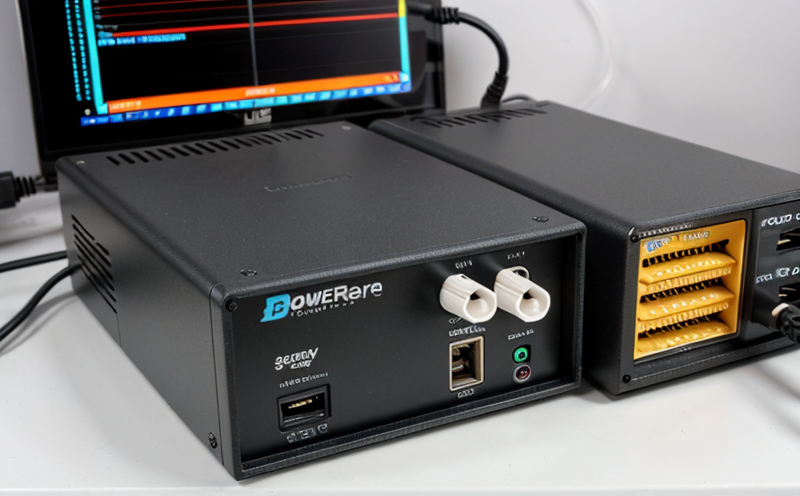DIN EN 62368 Safety Testing for External Power Supplies
The DIN EN 62368-1:2014 Standard on safety of household and similar electrical appliances applies to external power supplies (EPS) used in consumer electronics, medical devices, and industrial equipment. This standard ensures that EPS are safe for use by consumers and professionals alike. It addresses potential hazards such as electric shock, fire risk, and thermal stress.
The testing process under DIN EN 62368-1 involves a series of rigorous procedures aimed at identifying safety defects in the design, construction, labeling, and operation of EPS. Compliance with this standard is crucial for manufacturers to ensure their products meet international safety requirements before being sold or used globally.
Key aspects of testing include:
- Thermal stability under overload conditions
- Insulation integrity against electrical leakage
- Energy absorption upon impact from drops and shocks
- Mechanical durability in various environmental conditions
The testing process typically involves the following steps:
- Sample Preparation: EPS units are selected randomly from production batches for testing.
- Initial Inspections: Visual inspections and checks of labeling ensure compliance with mandatory requirements.
- Functional Tests: Electrical continuity, output voltage regulation, overvoltage protection, and other functional parameters are checked.
- Mechanical Tests: Drop tests simulate accidental drops from a height onto hard surfaces to check structural integrity.
- Thermal Cycling: EPS units undergo thermal cycling between extreme temperatures to assess long-term reliability.
The results of these tests are documented in comprehensive reports, which form part of the compliance documentation. These reports must be submitted to regulatory bodies or notified to customers as required by law.
To ensure accurate and repeatable testing, specialized equipment such as environmental chambers for thermal cycling, drop testers, and multimeters is used. Compliance with DIN EN 62368-1 not only enhances product safety but also facilitates market access in countries that recognize this standard.
Industry Applications
DIN EN 62368-1:2014 finds application across multiple sectors, including consumer electronics, medical devices, and industrial equipment. Here are some specific areas where the standard is utilized:
| Application Sector | Description of Application |
|---|---|
| Consumer Electronics | External power supplies for smartphones, tablets, and other consumer devices. |
| Medical Devices | EPS used in portable medical equipment like defibrillators and patient monitors. |
| Industrial Equipment | EPS powering industrial robots and automated systems. |
The standard ensures that EPS are robust enough to withstand the rigors of everyday use, harsh environments, and accidental mishandling. This is particularly important in sectors where safety is paramount.
- Consumer Electronics: Ensures consumer safety by preventing electrical accidents.
- Medical Devices: Protects patients from potential harm due to EPS failures.
- Industrial Equipment: Enhances operational reliability and reduces downtime in critical applications.
The diverse range of EPS covered by DIN EN 62368-1 includes linear regulators, switching regulators, AC-to-DC converters, and DC-to-DC converters. Testing under this standard guarantees that these components meet stringent safety criteria across all relevant environments.
International Acceptance and Recognition
DIN EN 62368-1:2014 is widely accepted in numerous countries, with its principles being adopted by various international standards bodies. It has been harmonized into the U.S. UL/CSA standard for EPS safety.
- European Union: EPS sold within EU member states must comply with this standard to be CE marked.
- Australia and New Zealand: The standard is recognized under AS/NZS 62368-1:2014.
- United States: The standard aligns closely with UL/CSA requirements, ensuring seamless compliance for exports to North America.
The widespread adoption of DIN EN 62368-1 reflects its importance in promoting global safety standards. Compliance with this standard ensures that EPS are safe and reliable across different markets, reducing the need for multiple certifications.
- Harmonization: The standard is harmonized with ISO/IEC 60950-1:2018 for IT equipment safety.
- Sector-Specific Compliance: EPS used in medical devices are also covered by IEC 60601 standards, ensuring comprehensive safety across all relevant sectors.
The international recognition of DIN EN 62368-1 enhances the global reputation of manufacturers who comply with this standard. It provides a robust framework for testing and certification that is accepted worldwide, facilitating easier market entry and increased consumer trust.
Environmental and Sustainability Contributions
DIN EN 62368-1:2014 not only ensures safety but also contributes to environmental sustainability by promoting the design of safer, more efficient EPS. The standard encourages manufacturers to minimize material waste during production and to use environmentally friendly materials where possible.
By ensuring that EPS are robust and reliable, this standard reduces the likelihood of product failures leading to premature disposal or replacement. This extends the lifecycle of products and minimizes electronic waste, aligning with broader sustainability goals.
- Material Efficiency: Encourages the use of recyclable materials in EPS construction.
- Energy Conservation: Promotes the design of more efficient power conversion processes to reduce energy losses.
- Eco-Friendly Packaging: Supports sustainable packaging practices that minimize environmental impact during transport and disposal.
The standard also addresses the issue of obsolescence by ensuring that EPS are designed with future generations in mind. This helps prevent unnecessary waste and supports a circular economy approach to manufacturing.





